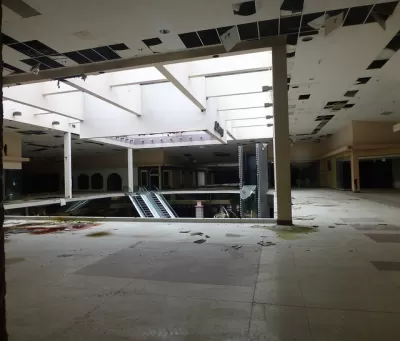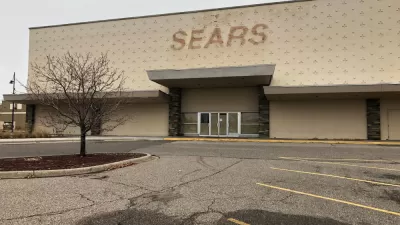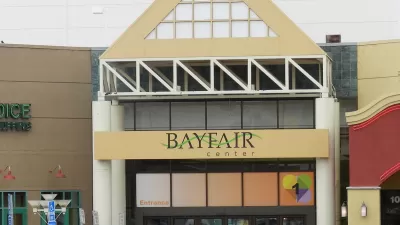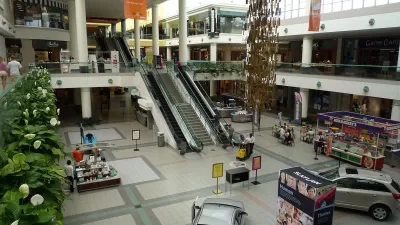A PBS Newshour economic correspondent visits the sites of former malls in Ohio and Massachusetts, some successfully repurposed, others in construction, and one in decay, speaking with economic experts along the way about the future of the mall.

Paul Solman begins his six minute report (video, audio + text) at the decaying 1.3 million-square-foot Rolling Acres Mall in Akron, Ohio, i.e., the "poster child for a recent phenomenon in America, the dead mall."
The 50-acre mall, which offered 140 stores at it peak, opened in 1975, was down to "20-odd stores" by May, 2007, and went dark the next year. Amanda Weinstein of the University of Akron explains how outlets and discount stores began to replace the mall in this blue-collar area.
Solman then launches into the history of the great American indoor malls. "In the 1950s, car culture spawned the suburbs and launched a half-century mall boom: 1,500 built from 1956 to 2005," states Solman. "But barely 1,000 indoor malls are left today, not a single new one built since 2006."
Solman's next guest, Leonard Schlesinger, a retail expert from the Harvard Business School, states, "Malls have been declining for years and will continue to decline." And he's not just referring to malls like Rolling Hills.
I’m talking about the high-quality malls that have been...what we call the A malls. The B malls and C malls, the ones that have never drawn high-end customer bases or high-end traffic, they’re already in the process of being repurposed in all sorts of ways.
Malls have been repurposed into bowling alleys, storage facilities, etc., and, according to Schlesinger, "15 percent of malls are expected to fail or be converted into non-retail space in the next decade."
In some cases the repurposing takes on adaptive reuse as in the case of "(t)he redevelopment of One Hundred Oaks from a dying shopping mall into a (LEED-certified) hybrid retail/medical mixed-use facility," described by Nashville Business Journal guest blogger, Walt Burton.
Other sites may be "de-malled," states Solman, as in the case of "the Atrium Mall in upscale Chestnut Hill, Massachusetts, now a construction site."
Solman goes on to describe successfully repurposed malls, one redeveloped into an upscale theater (which he visits). Schlesinger opines that "movies, gyms, restaurants and entertainment may be the new normal."
What helps, of course, is location.
Chestnut Hill, with its evermore well-heeled residents, is a much better mall bet than working-class Akron, Ohio, where the only use of Rolling Acres these days is a storage facility tucked away in one small wing of the complex.
He ends on a grim note for that real estate, calling it "a post-apocalyptic vision of shopping mall America."
FULL STORY: Once temples of American commerce, indoor malls lose shoppers to e-stores

Maui's Vacation Rental Debate Turns Ugly
Verbal attacks, misinformation campaigns and fistfights plague a high-stakes debate to convert thousands of vacation rentals into long-term housing.

Planetizen Federal Action Tracker
A weekly monitor of how Trump’s orders and actions are impacting planners and planning in America.

San Francisco Suspends Traffic Calming Amidst Record Deaths
Citing “a challenging fiscal landscape,” the city will cease the program on the heels of 42 traffic deaths, including 24 pedestrians.

Defunct Pittsburgh Power Plant to Become Residential Tower
A decommissioned steam heat plant will be redeveloped into almost 100 affordable housing units.

Trump Prompts Restructuring of Transportation Research Board in “Unprecedented Overreach”
The TRB has eliminated more than half of its committees including those focused on climate, equity, and cities.

Amtrak Rolls Out New Orleans to Alabama “Mardi Gras” Train
The new service will operate morning and evening departures between Mobile and New Orleans.
Urban Design for Planners 1: Software Tools
This six-course series explores essential urban design concepts using open source software and equips planners with the tools they need to participate fully in the urban design process.
Planning for Universal Design
Learn the tools for implementing Universal Design in planning regulations.
Heyer Gruel & Associates PA
JM Goldson LLC
Custer County Colorado
City of Camden Redevelopment Agency
City of Astoria
Transportation Research & Education Center (TREC) at Portland State University
Jefferson Parish Government
Camden Redevelopment Agency
City of Claremont





























